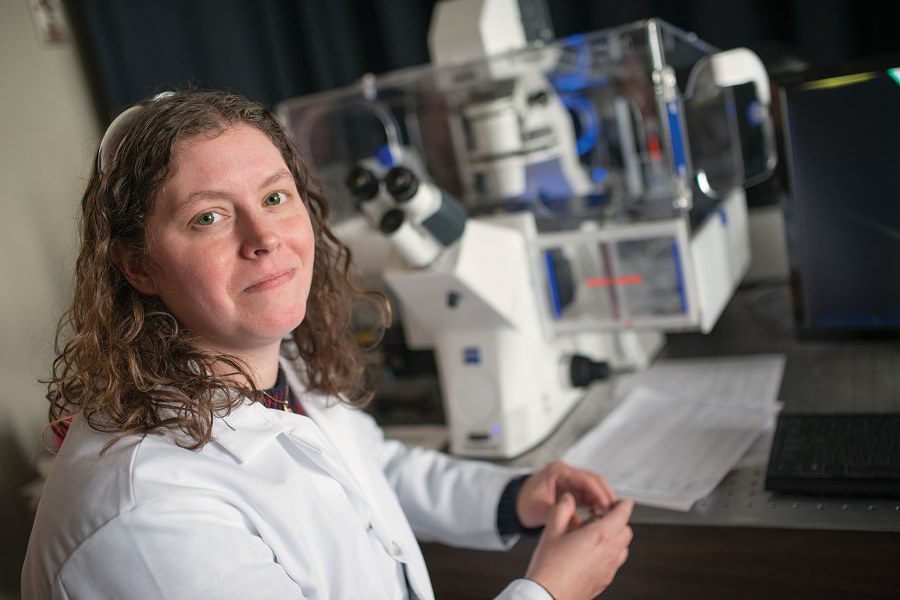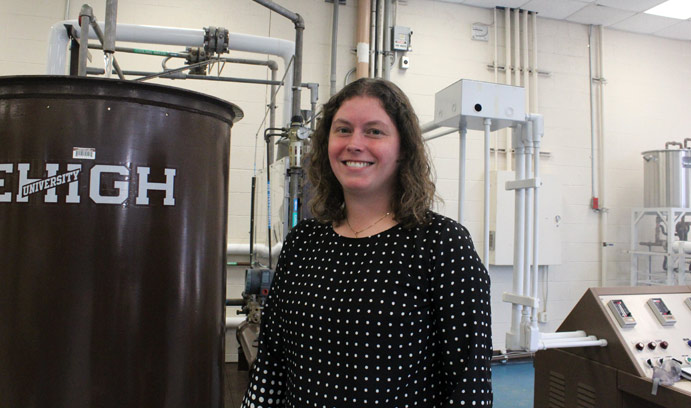Finding new uses for the versatile polymeric gel

In one of her projects, Kelly Schultz is using rheology to try to gain a deeper understanding of the gelation process that is used to enhance petroleum recovery. (Photo by Ryan Hulvat)

Lehigh professor Kelly Schultz, assistant professor of chemical and biomolecular engineering (Photo by Mikaila Skaroff/Lehigh University)
Substances with a complex microstructure, from blood to polymeric liquids, exhibit changes in behavior when they are subjected to external forces. They may deform elastically or break apart. When combined with liquids and malleable solids, these substances change their properties in ways that researchers can exploit for practical uses.
Kelly Schultz, assistant professor of chemical and biomolecular engineering, is an expert in rheology, the study of minute changes, or deformation, in matter when a force is applied. In one project, she is investigating how synthetic hydrogel materials interact with human cells to build synthetic matrices for tissue regeneration. In another, she is studying chemically cross-linked gels. Schultz also studies the behavior of colloidal gels used in home care products and cosmetics.
Schultz recently won an international honor from TA Instruments, the leading manufacturer of analytical instruments for thermal analysis, rheology and microcalorimetry, and an award from American Chemical Society’s (ACS) Petroleum Research Fund.
TA Instruments named Schultz a Distinguished Young Rheologist and provided her with a rheometer, a tool that enables researchers to push, pull or tear fluid materials and measure the resulting effect, such as changes in stiffness or viscosity.
“It’s a very precise instrument to poke at something,” Schultz says of the AR-G2 Rheometer.
The new instrument will help Schultz develop polymeric hydrogel materials for wound healing, tissue regeneration and other medical applications. She and her graduate students are also developing microrheological techniques that measure how synthetic hydrogel scaffolds affect and interact with human mesenchymal stem cells.
“If we can better understand that process,” she says, “we can make better materials that can manipulate cells and get them to do what we want.”
ACS’s Petroleum Research Fund awarded Schultz a $110,000 Doctoral New Investigator Grant for her studies of the material properties of chemically cross-linked polymeric gels, which are used in enhanced oil recovery and petroleum research. Her group is using rheology to try to gain a deeper understanding of the gelation process and to adjust it for the specific properties needed in this application.
Current methods of extracting crude oil involve fracturing minerals in the ground and using harmful chemicals to prevent water from entering those fractures.
“The gel would be inserted into the fracture to create a barrier against the water,” she says. “We made it photopolymerizable, which means it goes in as a liquid and becomes a gel when you shine light on it. This gel would provide a more environmentally friendly solution."
Posted on:

